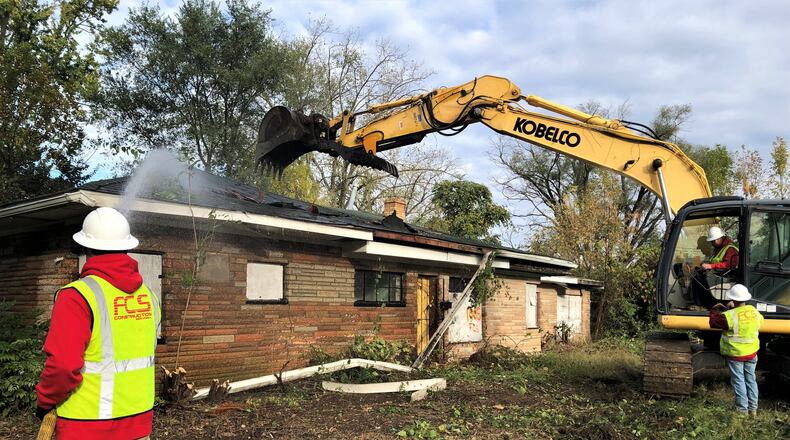That decision made the land bank eligible to go after more than $1 million in leftover state-controlled funding to bulldoze about nearly 100 additional properties in Dayton.
“The land bank was very aggressive and they did what they called ‘oversubscribed,’ so they purchased more buildings than they had money for, and it was a good bet on their part,” said Todd Kinskey, Dayton’s director of planning and community development.
MORE: Most of Dayton demolition funds going to west side neighborhoods
Blight is one of citizens’ top complaints, and residents who live near empty, dilapidated homes that are being torn down thanks to the extra available demolition funds are grateful for the work.
“It needs to go,” said Donna Kemps, who lives across the street from a vacant home that on Thursday was torn down in the Westwood neighborhood. “I am very glad.”
As of Sept. 30, the Montgomery County Land Bank had spent $18.6 million to demolish 1,088 housing units through the Neighborhood Initiative Program (NIP), according to the Ohio Housing Finance Agency.
The program, administered by the state, provides federal Hardest Hit Funds for blight removal to try to stabilize and restore neighborhoods and housing markets.
More than 80 percent of the homes the Montgomery County Land Bank has torn down through NIP are located in the city of Dayton, or about 874 units, the land bank said.
The city has benefited from more than $16 million in NIP-funded demolition since the program took off in 2014, according to land bank data.
The Hardest Hit Fund program is winding down, and NIP is expected to end in 2020, according to state and city officials.
The Ohio Housing Finance Agency pulled money back from land banks across the state that did not spend their full allocations.
Participating land banks are eligible for those leftover funds and can request up to $12,500 for every vacant and blighted residential structure they own and can take down within 90 days, said Dorcas Jones, a spokeswoman for the Ohio Housing Finance Agency.
The Montgomery County Land Bank has requested additional funds to take down about 102 structures, Jones said. Most of the properties are in Dayton.
MORE: Former fairgrounds demolition work starting: ‘We are preparing for the future’
Foreclosing on a property takes about a year to complete, and land banks must own residential properties they knock down under the Neighborhood Initiative Program, said Mike Grauwelman, executive director of the Montgomery County Land Bank.
The land bank decided to acquire more residential properties in Dayton than it had the money to remove, in the hopes that additional funding would become available, he said.
“We wanted to be more aggressive in terms of the acquisition of the properties so we could take advantage of what we’re now seeing, which is funds being pulled back and made available,” Grauwelman said. “Doing nothing was the alternative — just let the properties sit on the landscape.”
There was no chance the land bank could get inventory in time to meet the 90-day completion deadline if it had not taken a gamble and “oversubscribed,” Grauwelman said.
“It was a deliberate strategy on our part to do that, and the city supported that approach,” he said.
The local land bank completed its scheduled demolition work early and in recent months has made three requests for additional funds from the Ohio Housing Financing Agency totalling about $1.4 million, officials said.
MORE: Corruption probe linked to city of Dayton’s demolition contracts
The land bank is seeking reimbursement on its first request and expects to complete its second and third round of demolition work by the deadline, Grauwelman said. The land bank hopes to tear down another 82 properties.
With 53 properties in the process, the number of demolished homes in the city will be about 925.
On Thursday, a crew of workers with FCS Construction Services Inc. used an excavator to knock down a one-story home at 1005 Roseland Ave.
The structure was quickly reduced to debris. But the clean-up will take days, which includes removing brush, dead trees, the foundation or basement, as well as seeding the site.
“With this program with the county land bank, they want a clean, pristine lot,” said Sean Frazee, president of FCS Construction Services.
Frazee said neighbors come up and thank his crews almost every time FCS Construction demolishes an eyesore.
He said his company has torn down homes that have sat vacant for as long as 18 years. He said abandoned homes attract criminal activities, trash and illegal dumping and hurt surrounding properties.
Kemps, who has lived across from the 1005 Roseland Ave. property for eight or nine years, said the home has been a nuisance since she moved in and has attracted wild animals and packs of roaming dogs.
She said the animals are a risk to health and safety. She operates a daycare center at her home.
Kemps said she is happy to see the abandoned property eliminated. She just wishes another nearby vacant home could be torn down, as well.
When NIP comes to a close next year, the city will focus solely on properties in its nuisance program, officials said.
City officials say demolition remains a priority, but it’s likely the number of structures demolished in the city will decline significantly because of the drying up of NIP funds.
The city spends some its own general fund money and other federal dollars it receives on demolition, but that has been just a fraction of NIP spending.
The city estimates there are still about 5,000 vacant buildings in Dayton.
About the Author

